Qualitative Behavioural Assessment as a Method to Identify Potential Stressors during Commercial Sheep Transport
Simple Summary
Abstract
1. Introduction
2. Materials and Methods
2.1. Animals and Transportation
2.2. Study A: Comparison of 1. Trailer Crate Design, 2. Sheep Breed and 3. Point of Origin
2.3. Study B: Comparison of the Deck Level within a Crate
2.4. Qualitative Behavioural Assessment
2.4.1. Selecting Footage for Scoring Clips
2.4.2. Observer Demographics
2.5. Viewing Sessions
2.6. Statistical Analyses
2.7. Survey of Drivers
3. Results
3.1. Study A: Comparison of 1. Trailer Crate Design, 2. Sheep Breed and 3. Point of Origin
3.1.1. Study A1 Trailer Crate Design: Standard Crate vs. Convertible Crate
3.1.2. Study A2 Sheep Breed: Merino vs. Fat-Tail Sheep
3.1.3. Study A3 Point of Origin: Feedlot vs. Saleyard
3.2. Study B: Comparison of the Deck Level within a Crate
3.2.1. Study B1 Deck Level: Standard Crate Upper vs. Lower Deck
3.2.2. Study B2 Deck Level: Convertible Crate Upper vs. Lower Deck
3.2.3. Study B3 Standard versus Convertible Crate: Upper and Lower Deck
3.3. Driver Questionnaire
- Five drivers believed that the industry required better enforcement of withholding (curfew) periods.
- Drivers expressed concern about the waiting time at the wharf prior to sheep being loaded for export.
- Three drivers believed that loading density is an important priority; in particular, the density should be slightly lower, especially on long distance trips.
- Two drivers stated that education was required for producers to better prepare animals for transport and therefore improve loading and reduce transport stress and to understand the benefits of lower densities. Such preparation could include habituation to loading ramps, handling and humans, and education on the design of loading facilities and minimum requirements (e.g., a raised loading ramp).
- Two drivers identified that they required better support in refusing to load animals that they believed were in poor condition or not fit to load.
- condition of animal and impact of condition on stress and welfare during transport;
- having the right to refuse an emaciated or pregnant animal, guidelines for stocking rate during transport;
- rest yards at east-west state border with feed and water available; and
- driver education for handling sheep during loading and unloading.
- body position: lying down, in corner of crate or underneath other sheep, legs out of crate;
- movements such as limping or tucked up when loading or unloading;
- breathing style: reparation distress, tongue out when panting;
- general demeanour: head down, position of eye; and
- vocalisation.
4. Discussion
4.1. Study A1: Trailer Crate Design
4.2. Study A2: Sheep Breed
4.3. Study A3: Point of Origin
4.4. Study B: Deck Level
4.5. Limitations of This Study
4.6. Driver Questionnaire
5. Conclusions
Supplementary Materials
Author Contributions
Funding
Acknowledgments
Conflicts of Interest
References
- Parrott, R.F.; Hall, S.J.G.; Lloyd, D.M. Heart rate and stress hormone responses of sheep to road transport following two different loading procedures. Anim. Welf. 1998, 7, 257–267. [Google Scholar]
- Knowles, T.G.; Warriss, P.D.; Brown, S.N.; Edwards, J.E. Effects of stocking density on lambs being transported by road. Vet. Rec. 1998, 142, 503–509. [Google Scholar] [CrossRef] [PubMed]
- Tarrant, P.V.; Kenny, F.J.; Harrington, D.; Murphy, M. Long distance transportation of steers to slaughter: effect of stocking density on physiology, behaviour and carcass quality. Livest. Prod. Sci. 1992, 30, 223–238. [Google Scholar] [CrossRef]
- Warriss, P.D. The welfare of slaughter pigs during transport. Anim. Welf. 1998, 7, 365–381. [Google Scholar]
- Fisher, A.D.; Stewart, M.; Tacon, J.; Matthews, L.R. The effects of stock crate design and stocking density on environmental conditions for lambs on road transport vehicles. N. Z. Vet. J. 2002, 50, 148–153. [Google Scholar] [CrossRef] [PubMed]
- Cockram, M.S.; Baxter, E.M.; Smith, L.A.; Bell, S.; Howard, C.M.; Prescott, R.J.; Mitchell, M.A. Effect of driver behaviour, driving events and road type on the stability and resting behaviour of sheep in transit. Anim. Sci. 2004, 79, 165–176. [Google Scholar]
- Miranda-de la Lama, G.C.; Monge, P.; Villarroel, M.; Olleta, J.L.; García-belenguer, S.; María, G.A. Effects of road type during transport on lamb welfare and meat quality in dry hot climates. Trop. Anim. Health Prod. 2011, 43, 915–922. [Google Scholar] [CrossRef] [PubMed]
- Fisher, M.W.; Muir, P.D.; Gregory, N.G. The Animal Welfare Implications of Depriving Sheep of Feed to Facilitate Transport and Slaughter; MAF Technical Paper No 2011/37; Minister of Agriculture and Forestry: Wellington, New Zealand, 2011. [Google Scholar]
- Ruiz-de-la-Torre, J.L.; Velarde, A.; Manteca, X.; Diestre, A.; Gispert, M.; Hall, S.J.G.; Broom, D.M. Effects of vehicle movements during transport on the stress responses and meat quality of sheep. Vet. Rec. 2001, 148, 227–229. [Google Scholar] [CrossRef] [PubMed]
- Wemelsfelder, F. The scientific validity of subjective concepts in models of animal welfare. Appl. Anim. Behav. Sci. 1997, 53, 75–88. [Google Scholar] [CrossRef]
- Wemelsfelder, F. How animals communicate quality of life: The qualitative assessment of behaviour. Anim. Welf. 2007, 16, 25–31. [Google Scholar]
- Wemelsfelder, F.; Hunter, E.A.; Mendl, M.T.; Lawrence, A.B. The spontaneous qualitative assessment of behavioural expressions in pigs: first explorations of a novel methodology for integrative animal welfare measurement. Appl. Anim. Behav. Sci. 2000, 67, 193–215. [Google Scholar] [CrossRef]
- Phythian, C.J.; Michalopoulou, E.; Cripps, P.J.; Duncan, J.S.; Wemelsfelder, F. On-farm qualitative behaviour assessment in sheep: Repeated measurements across time, and association with physical indicators of flock health and welfare. Appl. Anim. Behav. Sci. 2016, 175, 23–31. [Google Scholar] [CrossRef]
- Fleming, P.A.; Clarke, T.; Wickham, S.L.; Stockman, C.A.; Barnes, A.L.; Collins, T.; Miller, D.W. The contribution of qualitative behavioural assessment to appraisal of livestock welfare. Anim. Prod. Sci. 2016, 56, 1569–1578. [Google Scholar] [CrossRef]
- Wickham, S.L.; Collins, T.; Barnes, A.L.; Miller, D.W.; Beatty, D.T.; Stockman, C.A.; Blache, D.; Wemelsfelder, F.; Fleming, P.A. Validating the Use of Qualitative Behavioral Assessment as a Measure of the Welfare of Sheep During Transport. J. Appl. Anim. Welf. Sci. 2015, 18, 269–286. [Google Scholar] [CrossRef] [PubMed]
- Wickham, S.L.; Collins, T.; Barnes, A.L.; Miller, D.W.; Beatty, D.T.; Stockman, C.A.; Blache, D.; Wemelsfelder, F.; Fleming, P.A. Qualitative behavioral assessment of transport-naïve and transport-habituated sheep. J. Anim. Sci. 2012, 90, 4523–4535. [Google Scholar] [CrossRef] [PubMed]
- Stockman, C.A.; Collins, T.; Barnes, A.L.; Miller, D.W.; Wickham, S.L.; Beatty, D.T.; Blache, D.; Wemelsfelder, F.; Fleming, P.A. Flooring and driving conditions during road transport influence the behavioural expression of cattle. Appl. Anim. Behav. Sci. 2013, 143, 18–30. [Google Scholar] [CrossRef]
- Stockman, C.A.; Collins, T.; Barnes, A.L.; Miller, D.W.; Wickham, S.L.; Beatty, D.T.; Blache, D.; Wemelsfelder, F.; Fleming, P.A. Qualitative behavioural assessment of cattle naïve and habituated to road transport. Anim. Prod. Sci. 2011, 51, 240–249. [Google Scholar] [CrossRef]
- Broom, D.M. The effects of land transport on animal welfare. Revue Scientifique et Technique Office International des Épizooties 2005, 24, 683. [Google Scholar] [CrossRef]
- Grandin, T.; Gallo, C. Cattle transport. In Livestock Handling and Transport; Grandin, T., Ed.; CABI Publishing: Wallingford, UK, 2007; pp. 134–154. [Google Scholar]
- Van De Water, G.; Heylen, T.; Swinnen, K.; Geers, R. The impact of vertical vibrations on the welfare of calves. Deutsch. Tierarztl. Wochenschr. 2003, 110, 111–114. [Google Scholar]
- Hall, S.J.G.; Bradshaw, R.H. Welfare aspects of the transport by road of sheep and pigs. J. Appl. Anim. Welf. Sci. 1998, 1, 235–254. [Google Scholar] [CrossRef] [PubMed]
- Dijksterhuis, G.B.; Heiser, W.J. The role of permutation tests in exploratory multivariate data analysis. Food Qual. Prefer. 1995, 6, 263–270. [Google Scholar] [CrossRef]
- Stockman, C.A.; Collins, T.; Barnes, A.L.; Miller, D.; Wickham, S.L.; Verbeek, E.; Matthews, L.; Ferguson, D.; Wemelsfelder, F.; Fleming, P.A. Qualitative behavioural assessment of the motivation for feed in sheep in response to altered body condition score. Anim. Prod. Sci. 2014, 54, 922–929. [Google Scholar] [CrossRef]
- Stockman, C.A.; McGilchrist, P.; Collins, T.; Barnes, A.L.; Miller, D.W.; Wickham, S.L.; Greenwood, P.L.; Cafe, L.M.; Blache, D.; Wemelsfelder, F.; et al. Qualitative behavioural assessment of cattle pre-slaughter and relationship with cattle temperament and physiological responses to the slaughter process. Appl. Anim. Behav. Sci. 2012, 142, 125–133. [Google Scholar] [CrossRef]
- Clarke, T.; Pluske, J.R.; Miller, D.W.; Collins, T.; Fleming, P.A. Parity influences the demeanour of sows at mixing into group housing. J. Appl. Anim. Welf. Sci. 2018, 21, 17–26. [Google Scholar] [CrossRef] [PubMed]
- Clarke, T.; Pluske, J.R.; Collins, T.; Miller, D.W.; Fleming, P.A. A quantitative and qualitative approach to the assessment of behaviour of sows upon mixing into group pens with or without a partition. Anim. Prod. Sci. 2017, 57, 1916–1923. [Google Scholar] [CrossRef]
- Navarro, G. Efecto de la Reducción de Densidad de Carga y Provisión de Agua Durante el Transporte Prolongado de Corderos Sobre el Bienestar Animal; Universidad Austral de Chile: Valdivia, Chile, 2008. (In Spanish) [Google Scholar]
- Huertas, S.M.; Gil, A.D.; Piaggio, J.M.; Van Eerdenburg, F.J.C.M. Transportation of beef cattle to slaughterhouses and how this relates to animal welfare and carcase bruising in an extensive production system. Anim. Welf. 2010, 19, 281–285. [Google Scholar]
- Hall, S.J.G.; Broom, D.M.; Kiddy, G.N.S. Effect of transportation on plasma cortisol and packed cell volume in different genotypes of sheep. Small Rumin. Res. 1998, 29, 233–237. [Google Scholar] [CrossRef]
- Miller, D.W.; Fleming, P.A.; Barnes, A.L.; Wickham, S.L.; Collins, T.; Stockman, C.A. Behavioural assessment of the habituation of feral rangeland goats to an intensive farming system. Appl. Anim. Behav. Sci. 2018, 199, 1–8. [Google Scholar] [CrossRef]
- Grandin, T. Assessment of stress during handling and transport. J. Anim. Sci. 1997, 75, 249–257. [Google Scholar] [CrossRef] [PubMed]
- Broom, D.M.; Goode, J.A.; Hall, S.J.G.; Lloyd, D.M.; Parrott, R.F. Hormonal and physiological effects of a15 hour road journey in sheep: Comparison with the responses to loading, handling and penning in the absence of transport. Br. Vet. J. 1996, 152, 593–604. [Google Scholar] [CrossRef]
- Phythian, C.; Michalopoulou, E.; Duncan, J.; Wemelsfelder, F. Inter-observer reliability of Qualitative Behavioural Assessments of sheep. Appl. Anim. Behav. Sci. 2013, 144, 73–79. [Google Scholar] [CrossRef]
- Wemelsfelder, F.; Nevison, I.; Lawrence, A.B. The effect of perceived environmental background on qualitative assessments of pig behaviour. Anim. Behav. 2009, 78, 477–484. [Google Scholar] [CrossRef]
- Fleming, P.A.; Wickham, S.L.; Stockman, C.A.; Verbeek, E.; Matthews, L.; Wemelsfelder, F. The sensitivity of QBA assessments of sheep behavioural expression to variations in visual or verbal information provided to observers. Animal 2015, 9, 878–887. [Google Scholar] [CrossRef] [PubMed]
- Grandin, T. Design of Ranch Corrals and Squeeze Chutes for Cattle. Great Plains Beef Cattle Handbook; Cooperative Extension Service: Oklahoma City, OK, USA, 1983. [Google Scholar]
- Gallo, C.; Tarumán, J.; Larrondo, C. Main factors affecting animal welfare and meat quality in lambs for slaughter in Chile. Animals 2018, 8, 165. [Google Scholar] [CrossRef] [PubMed]
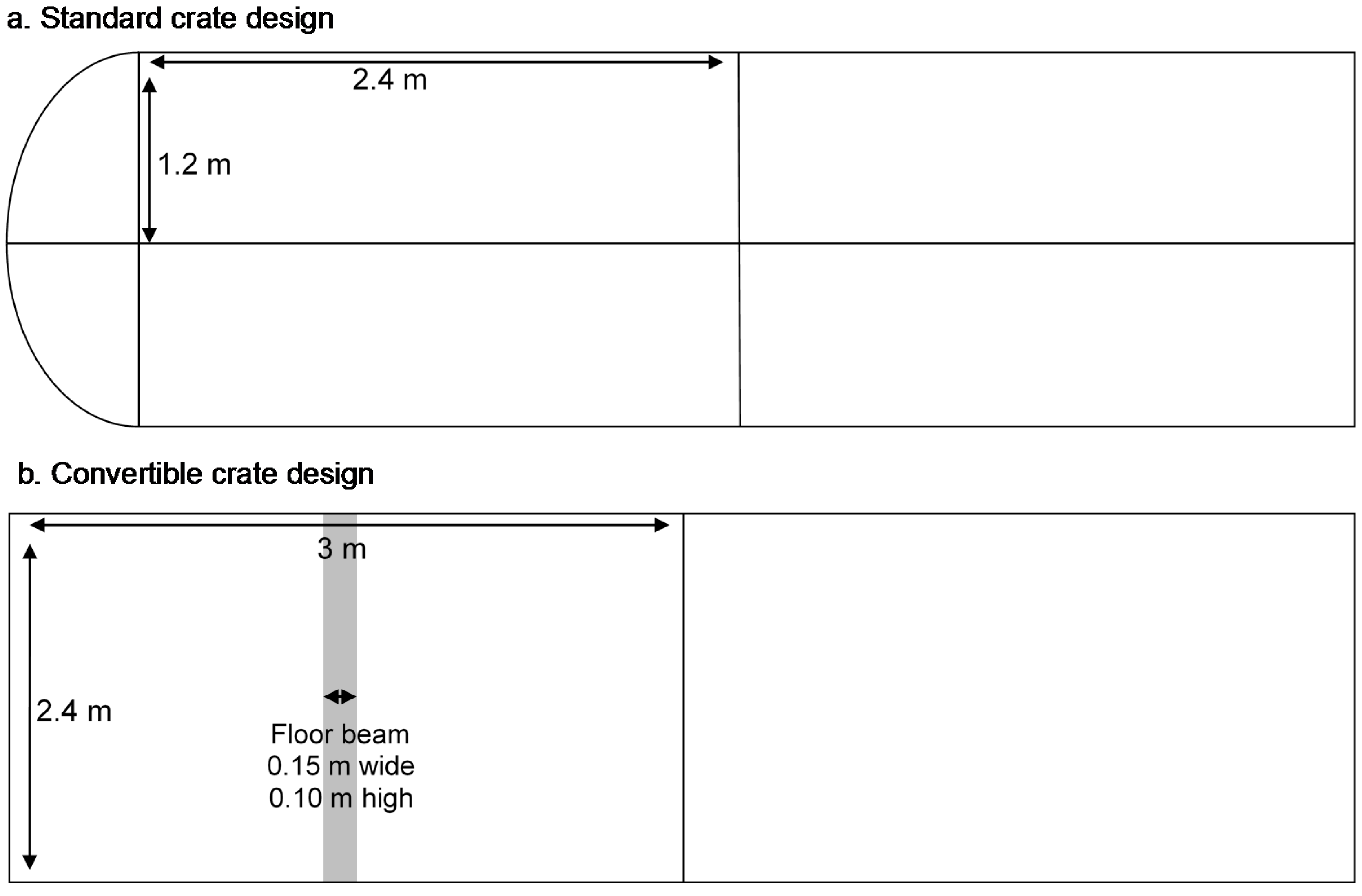

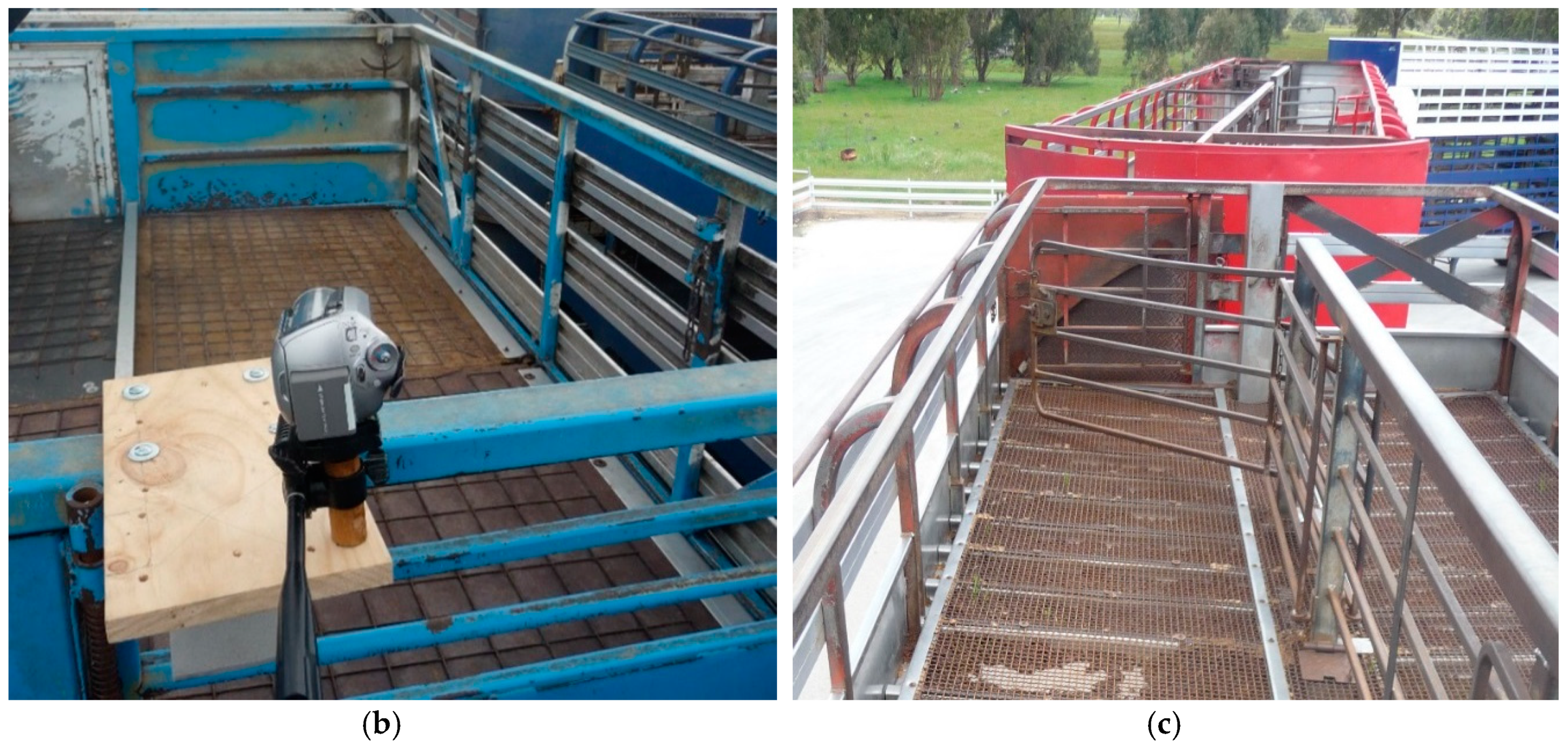
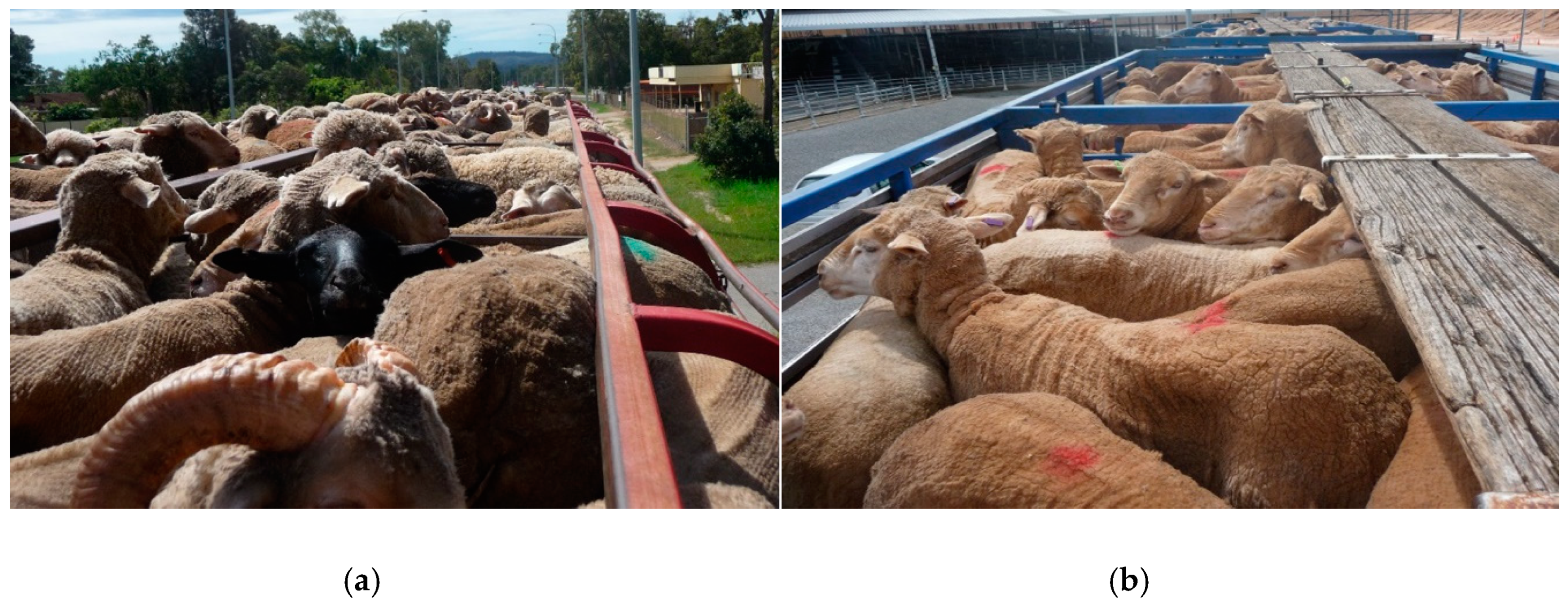
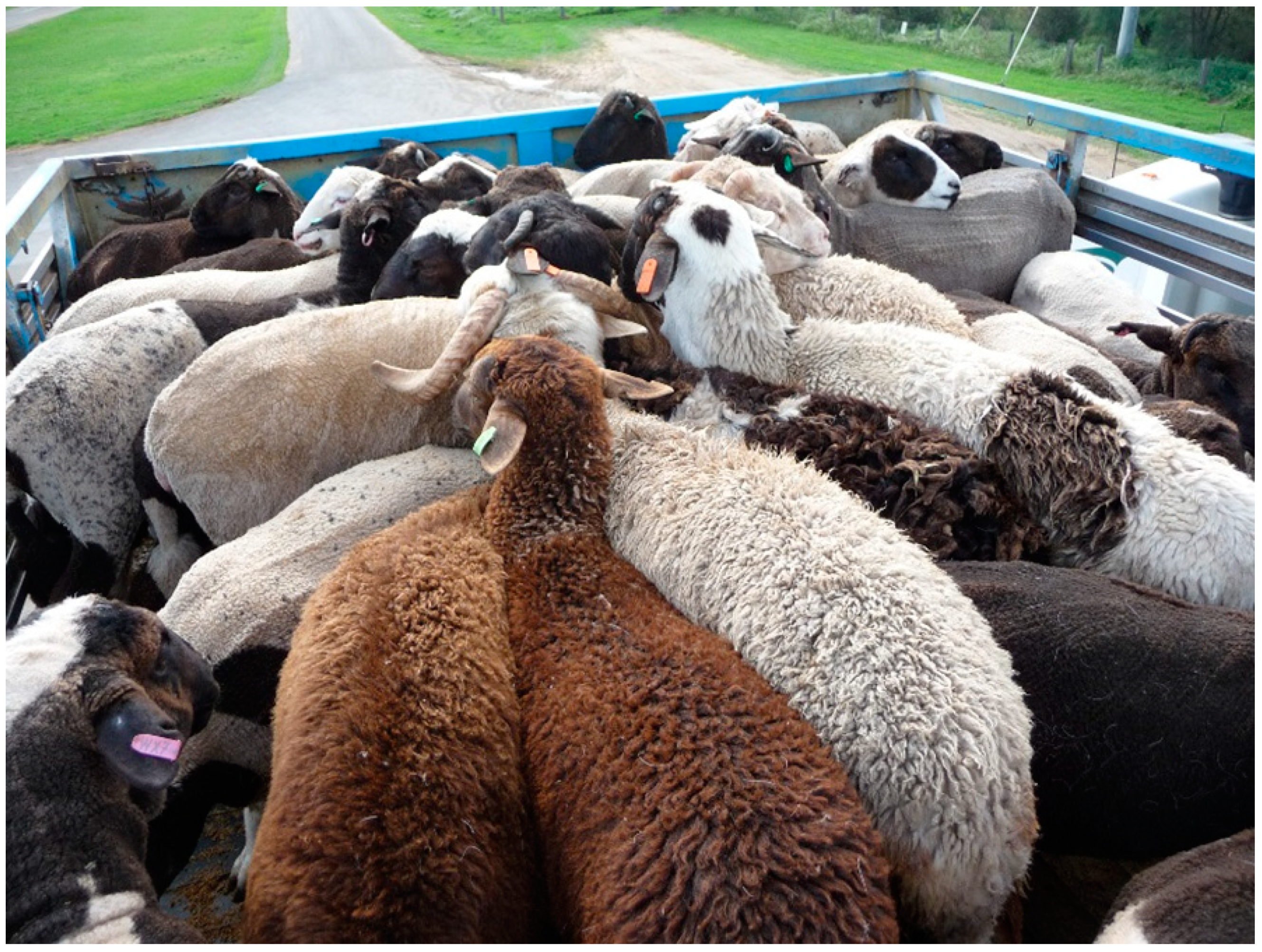
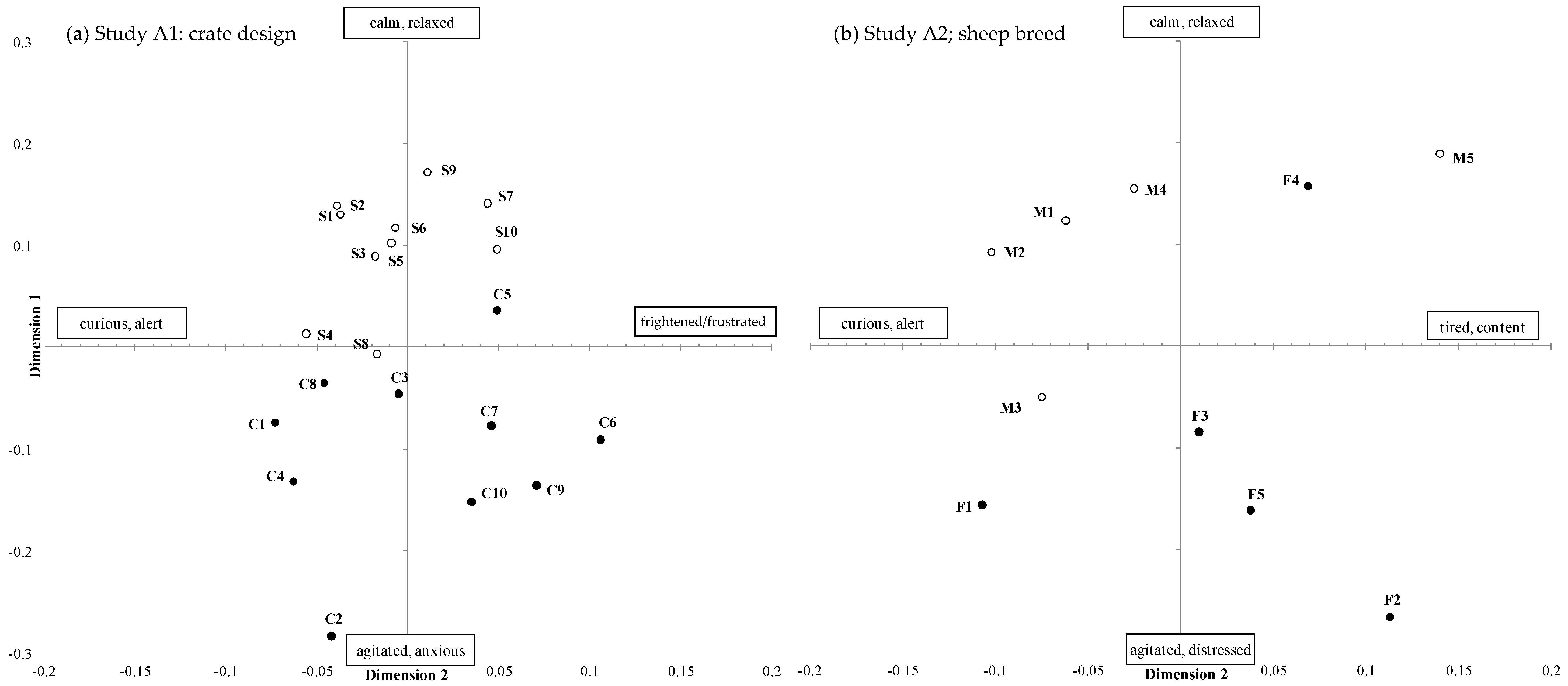

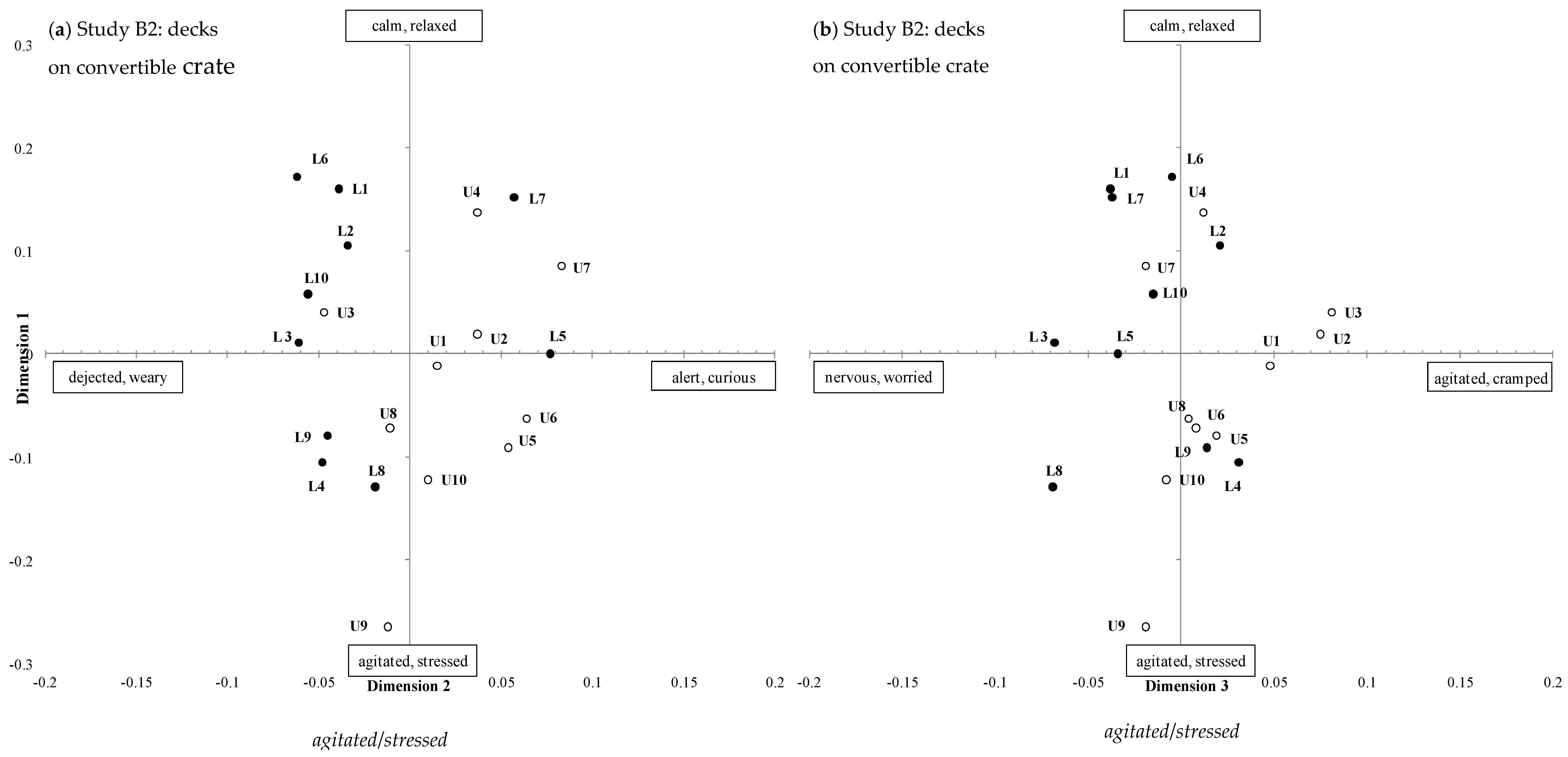
| Study | Vehicle Cate † S: Standard, C: Convertible | Deck U: Upper, L: Lower | Sheep M: Merino, F: Fat-Tail | Origin ‡ | Number of Video Clips Viewed by Observers |
|---|---|---|---|---|---|
| A1 Vehicle crate | S vs. C | U | M | FL | n = 10, 10 |
| A2 Sheep breed | S | U | M vs. F | FL | n = 5, 5 |
| A3 Point of origin | S | U | M | SY vs. FL | n = 10, 10 |
| B Deck level: | |||||
| B1 (SU-SL) | S | U vs. L | M | FL–W | n = 10, 10 |
| B2 (CU-CL) | C | U vs. L | M | FL–W | n = 10, 10 |
| B3 (SU-SL-CU-CL) | S vs. C | U vs. L | M | FL–W | n = 18, 18 |
| Attribute | Category: # of Observers | |
|---|---|---|
| Study A (26 observers) | ||
| Sex | Female: 21 | Male: 5 |
| Country of birth | Australia: 15 | Other: 11 |
| Residence | Urban: 24 | Rural: 2 |
| Area of study/employment: animal-related | Yes: 24 | No: 2 |
| Dietary preference: vegetarian | Yes: 4 | No: 22 |
| Purchasing habit: purchases own meat/eggs/dairy | Yes: 25 | No: 1 |
| Pet ownership | Yes: 22 | No: 4 |
| Level of experience with sheep | Low: 7; Medium: 4; High: 15 | |
| Age (years) | <19: 1 20–29: 15 30–39: 8 40–49: 1 50–59: 0 60–69: 1 >70: 0 | |
| Study B (26 observers) | ||
| Sex | Female: 16 | Male: 4 |
| Country of birth | Australia: 11 | Other: 9 |
| Residence | Urban: 16 | Rural: 4 |
| Area of study/employment: animal-related | Yes: 13 | No: 7 |
| Dietary preference: vegetarian | Yes: 4 | No: 16 |
| Purchasing habit: purchases own meat/eggs/dairy | Yes: 20 | No: 0 |
| Pet ownership | Yes: 19 | No: 1 |
| Level of experience with sheep | Low: 7 Medium: 5 High: 8 | |
| Age (years) | <19: 0 20–29: 8 30–39: 7 40–49: 2 50–59: 2 60–69: 0 >70: 1 | |
| Treatment, Procrustes Statistic † | GPA Dimension | Low Values | High Values | Treatment Effect |
|---|---|---|---|---|
| Study A | ||||
| A1: S-C PS: 56.64% (t99 = 43.8, p < 0.001) | 1 (53.2%) | Agitated (7), anxious (5), nervous (5), worried (5), concerned (3), scared (3), jumpy (2), fidgety (2), alert (2), distressed (2) | Calm (11), relaxed (7), settled (3), restful (2), comfortable (2), subdued, happy, tolerant, accepting, bored | Crate: F1, 6 = 48.85, p < 0.001 Sheep in a standard crate scored higher than sheep in a convertible crate Driver ID (random factor): F6, 487 = 5.90, p < 0.001 |
| 2 (8.5%) | Curious (7), alert (3), inquisitive (2), nervous (2), interested, confident, comfortable, puzzled, at ease, watchful | Frightened, frustrated, agitated, bored, annoyed, distressed, anxious, bossy | Crate: F1, 6 = 0.29, p = 0.609 Driver ID (random factor): F6, 487 = 26.84, p < 0.001 | |
| 3 (4.8%) | Tired (2), apprehensive, struggling, pissed off, sad, fidgety, certain, alert, sleepy, bored | Confident, relaxed, sleepy, depressed, settled, satisfied | Crate: F1, 6 = 0.96, p = 0.367 Driver ID (random factor): F6, 487 = 6.67, p < 0.001 | |
| A2: M-FT PS: 56.11% (t99 = 12.01, p < 0.001) | 1 (42.5%) | Agitated (6), distressed (6), nervous (5), anxious (4), jumpy (3), pushy (2), alert (2), wary (2), frustrated (2), fidgety (2) | Calm (6), relaxed (4), comfortable (4), happy (3), settled (2), patient (2), composed (2), restful, mellow, unphased | Breed: F1, 4 = 27.98, p = 0.006 Merino sheep scored higher than fat-tail sheep Driver ID (random factor): F2, 223 = 30.87, p < 0.001 |
| 2 (12.6%) | Curious (5), alert (4), inquisitive (4), worried (3), interested (2), comfortable (2), nervous (2), attentive, aware, confident | Tired (2), content (2), happy, calm, scared, settled, annoyed, anxious, frustrated, nervous | Breed: F1, 14 = 8.44, p = 0.011 Merino sheep scored lower than fat-tail sheep Driver ID (random factor): F2, 223 = 7.30, p = 0.001 | |
| 3 (9.9%) | Nervous (3), alert (3), interested (2), curious (2), annoyed (2), calm (2), jumpy, nonchalant, anticipating, restless | Relaxed (3), tired (2), alert (2), anxious (2), scared (2), comfortable (2), sleepy (2), unsure, insecure, resigned | Breed: F1, 3 = 0.05, p = 0.837 Driver ID (random factor): F2, 223 = 75.96, p < 0.001 | |
| A3: FL-SY PS: 49.2% (t99 = 29.051, p < 0.001) | 1 (46.6%) | Agitated (4), anxious (4), frightened (3), worried (3), nervous (3), panicked (3), scared (2), restless (2), jumpy, fretful | Calm (6), bored (3), relaxed, casual, accepting, placid, comfortable, settled, patient, composed | Origin: F1, 6 = 0.12, p = 0.745 Driver ID (random factor): F5, 469=27.51, p < 0.001 |
| 2 (10.7%) | Curious (3), happy (2), alert (2), bored (2), interested (2), comfortable, calm, settled, resigned, content | Curious (2), agitated (2), resigned, interested, tired, lethargic, depressed, struggling, distressed, bored | Origin: F1, 18 = 1.12, p = 0.304 Driver ID (random factor): F5, 469=4.21, p < 0.001 | |
| 3 (5.8%) | Nervous (2), curious (2), distressed, excited, interested, agitated, annoyed, alert | Comfortable (2), relaxed (2), aware, stressed, mellow, calm, settled, confident, happy, agitated | Origin: F1, 24 = 7.04, p = 0.014 Sheep from feedlot scored higher than sheep from saleyard Driver ID (random factor): F5, 469 = 3.11, p = 0.009 | |
| Study B | ||||
| B1: SU-SL PS: 42.75% (t99 = 16.45, p < 0.001) | 1 (35.9%) | Agitated (7), stressed (4), pushy (3), distressed (3), worried (3), uneasy (2), restless (2), nervous (2), scared(2), distressed (2) | Calm (7), comfortable (4), relaxed (2), happy (2), placid, quiet, accepting | Deck (S): F1, 377 = 0.41, p = 0.521 Driver ID (random factor): F2, 377 = 15.03, p < 0.001 |
| 2 (20.9%) | Miserable, unsure, tired, restful | Alert (9), curious (6), interested (5), happy (3), inquisitive (2), watchful (2), comfortable (2), observant, confused, confident | Deck (S): F1, 377 = 136.22, p < 0.001 Sheep transported in the upper deck scored higher than sheep transported in the lower deck Driver ID (random factor): F2, 377 = 6.04, p = 0.003 | |
| 3 (10.8%) | Nervous (2), agitated (2), stressed, distressed, settled, weary, wary, dejected, collected, confused | Stressed (2), alert (2), restless (2), distressed, adjusting, anxious, quiet, fidgety, unsupported, relaxed | Deck (S): F1, 377 = 25.40, p < 0.001 Sheep transported in the upper deck scored higher than sheep transported in the lower deck Driver ID (random factor): F2, 377 = 4.21, p = 0.015 | |
| B2: CU-CL PS: 45.34% (t99 = 23.67, p < 0.001) | 1 (56.1%) | Agitated (6), stressed (5), nervous (4), frightened (4), restless (4), distressed (3), uneasy (3), anxious (2), unsettled (2), worried (2) | Calm (9), relaxed (7), comfortable (6), happy (3), quiet (2), resolved, settled, at ease, resigned, restful | Deck (C): F1, 376 = 22.54, p < 0.001 Sheep transported in the upper deck scored higher than sheep transported in the lower deck Driver ID (random factor): F3, 376 = 32.58, p < 0.001 |
| 2 (8.5%) | Dejected, weary, agitated, tired, scared | Alert (6), curious (4), interested (2), confident (2), relaxed (2), happy, wary, observant, aware | Deck (C): F1, 376 = 22.54, p < 0.001 Sheep transported in the upper deck scored higher than sheep transported in the lower deck Driver ID (random factor): F3, 376 = 32.58, p < 0.001 | |
| 3 (7.8%) | Nervous, worried, unsure | Agitated (2), cramped (2), curious (2), alert, aware, interested, relaxed, squashed | Deck (C): F1, 376 = 49.17, p < 0.001 Sheep transported in the upper deck scored higher than sheep transported in the lower deck Driver ID (random factor): F3, 376 = 24.54, p < 0.001 | |
| B3: SU-SL-CU-CL PS: 36.86% (t99 = 32.699, p < 0.001) | 1 (43.2%) | Agitated (5), nervous (3), restless (3), uneasy (3), frightened (3), anxious (2), stressed (2), worried (2), distressed (2), confused (2) | Calm (7), relaxed (5), comfortable (4), happy, at ease, settled | Crate: F1, 5 =0.35, p = 0.581 Deck: F1, 6 = 0.01, p = 0.968 Crate x deck: F1, 5 = 0.63, p = 0.466 Driver ID (random factor): F5, 5 = 4.30, p = 0.065 |
| 2 (19.1%) | Distressed (2), stressed (2), bored, scared, freaked, miserable, quiet, unsure, worried, sad | Curious (8), alert (7), aware (3), interested (2), observant (2), confident, happy, relaxed | Crate: F1, 6 = 0.47, p = 0.525 Deck: F1, 8 = 12.35, p = 0.008 Sheep transported in the upper deck scored higher than sheep transported in the lower deck Crate x deck: F1, 5 = 0.51, p = 0.509 Driver ID (random factor): F5, 5 = 1.42, p = 0.355 | |
| 3 (8.8%) | Nervous (2), curious (2), distressed, excited, interested, agitated, annoyed, alert | Quiet (2), collected, calm, confused, accepting, aloof, peaceful | Crate: F1, 5 < 0.01, p = 0.994 Deck: F1, 4 = 4.50, p = 0.114 Crate x deck: F1, 4 = 0.82, p = 0.412 Driver ID (random factor): F5, 5 = 2.02, p = 0.222 |
© 2018 by the authors. Licensee MDPI, Basel, Switzerland. This article is an open access article distributed under the terms and conditions of the Creative Commons Attribution (CC BY) license (http://creativecommons.org/licenses/by/4.0/).
Share and Cite
Collins, T.; Stockman, C.A.; Barnes, A.L.; Miller, D.W.; Wickham, S.L.; Fleming, P.A. Qualitative Behavioural Assessment as a Method to Identify Potential Stressors during Commercial Sheep Transport. Animals 2018, 8, 209. https://doi.org/10.3390/ani8110209
Collins T, Stockman CA, Barnes AL, Miller DW, Wickham SL, Fleming PA. Qualitative Behavioural Assessment as a Method to Identify Potential Stressors during Commercial Sheep Transport. Animals. 2018; 8(11):209. https://doi.org/10.3390/ani8110209
Chicago/Turabian StyleCollins, Teresa, Catherine A. Stockman, Anne L. Barnes, David W. Miller, Sarah L. Wickham, and Patricia A. Fleming. 2018. "Qualitative Behavioural Assessment as a Method to Identify Potential Stressors during Commercial Sheep Transport" Animals 8, no. 11: 209. https://doi.org/10.3390/ani8110209
APA StyleCollins, T., Stockman, C. A., Barnes, A. L., Miller, D. W., Wickham, S. L., & Fleming, P. A. (2018). Qualitative Behavioural Assessment as a Method to Identify Potential Stressors during Commercial Sheep Transport. Animals, 8(11), 209. https://doi.org/10.3390/ani8110209





